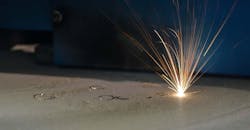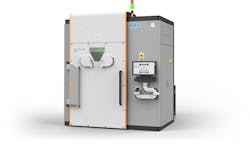3D Systems’ 2-Laser Process Shows Promise Printing Critical Parts
A European additive-manufacturing business is expanding its market potential by adopting 3D Systems’ dual-laser DMP Flex 350 direct metal printing technology for contract production of titanium parts, for various industrial and medical device components. Amnovis, in Aarschot, Belgium, reportedly has improved its metal AM productivity and reduced production costs, too.
3D Systems’ Direct Metal Printing is a laser-sintering/powder-bed fusion printing process, with a build volume of 275x275x420 mm (10.82x10.82x16.54 in.; WxDxH.) It has a proprietary vacuum chamber for printing reactive materials, such as titanium, in a low-oxygen (<30 ppm) atmosphere with low argon-gas consumption. Single- and dual-laser process configurations are available.
The DMP platform uses the 3DXpert metal AM software developed by Oqton, recently acquired by 3D Systems, which handles design preparation, optimization, and 3D printing to optimize the workflow from design to printing.According to the system developer, DMP Flex 350 Dual is effective for printing medical devices, aerospace components, turbomachinery, semiconductors, and automotive / motorsports parts.
“In order for our service bureau customers to gain a competitive advantage, they need to differentiate the services they provide while becoming increasingly responsive to customer requirements,” explained 3D Systems’ v.p. and segment leader Scott Anderson.
Amnovis’ founders were early adopters of laser powder-bed fusion additive manufacturing for titanium medical devices, like orthopedic and spinal implants. The DMP Flex 350 Dual printer is helping Amnovis to expand its potential for developing stock and patient-specific medical devices– and to introduce product and process enhancements that also may be applicable for aerospace, high-tech, and similarly regulated industrial applications.
“We’ve experienced a tremendous leap in 3D-printing efficiency by integrating 3D Systems’ DMP Flex 350 Dual into our workflow,” according to Amnovis co-founder and CEO Ruben Wauthle. “By scaling our high-end parts manufacturing for quality-critical applications in medical, high tech, and other industries, we ensure faster delivery at lower cost, while maintaining our high-quality standards."
Anderson describe the collaboration with Amnovis an “example of how we can apply our application development expertise and a broad range of integrated additive manufacturing solutions to help maximize productivity, reliability, uptime, and yield.
“By integrating the DMP Flex 350 Dual into its solution portfolio, Amnovis is delivering high-quality parts to their customers while realizing exceptional total cost of ownership,” he said.

